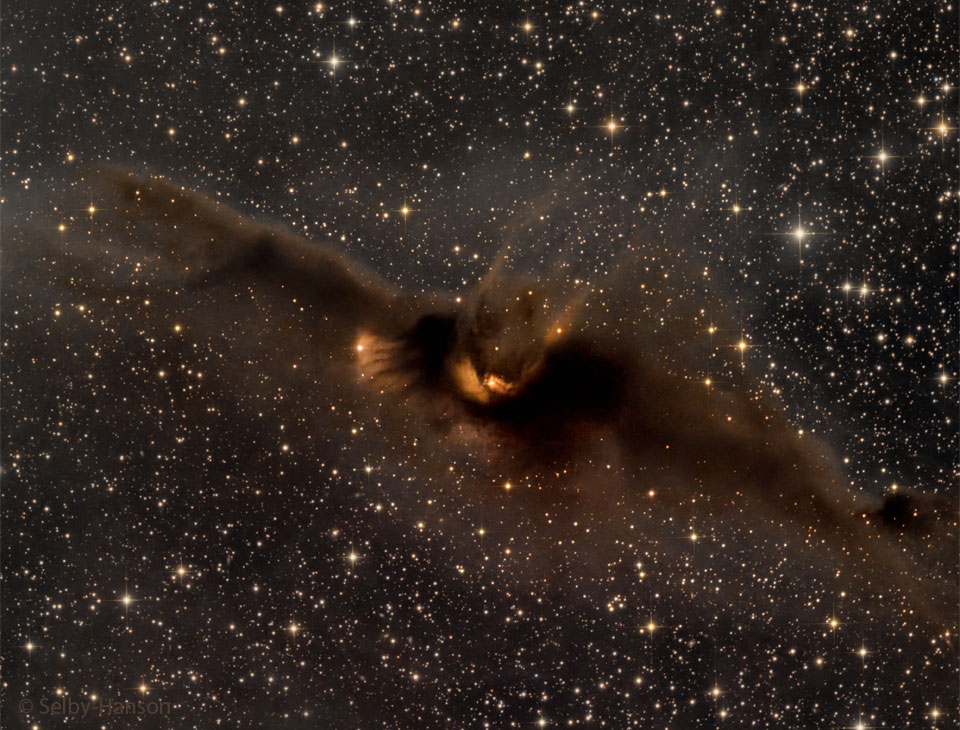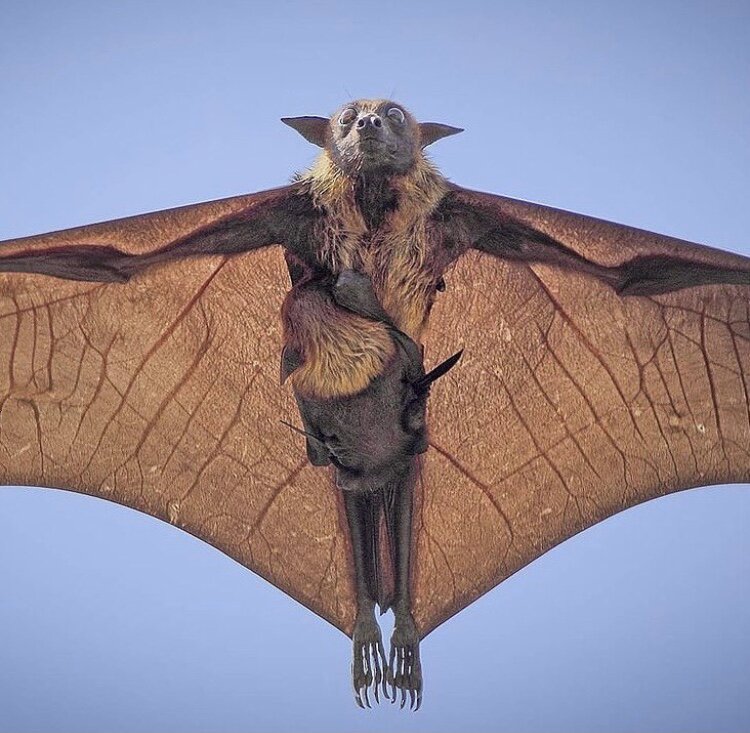Page 1 of 1
APOD: LDN 43: The Cosmic Bat Nebula (2024 Oct 27)
Posted: Sun Oct 27, 2024 4:05 am
by APOD Robot
 LDN 43: The Cosmic Bat Nebula
Explanation:
LDN 43: The Cosmic Bat Nebula
Explanation: What is the most spook-tacular nebula in the galaxy? One contender is LDN 43, which bears an astonishing resemblance to a vast cosmic
bat flying amongst the stars on a dark
Halloween night. Located about 1400
light years away in the constellation
Ophiuchus, this
molecular cloud is dense enough to
block light not only from background stars, but from wisps of gas lit up by the nearby
reflection nebula LBN 7. Far from being a harbinger of death, this 12-light year-long filament of gas and
dust is actually a
stellar nursery. Glowing with
eerie light, the bat is lit up from inside by
dense gaseous knots that have just formed
young stars.
Re: APOD: LDN 43: The Cosmic Bat Nebula (2024 Oct 27)
Posted: Sun Oct 27, 2024 4:35 am
by Ann
Yes, the Cosmic Bat Nebula does look like Batman in flight, I'll grant you that.
The Cosmic Bat Nebula is also known as LDN 43. LDN means Lynd's Dark Nebula. And the Cosmic Bat sure is dark, just like Batman. But unlike Batman, the Cosmic Bat is a mom. The eerily glowing orange patches in the Cosmic Bat are sites of star formation and newborn stars.
Ann
Re: APOD: LDN 43: The Cosmic Bat Nebula (2024 Oct 27)
Posted: Sun Oct 27, 2024 10:23 am
by AVAO
Ann wrote: ↑Sun Oct 27, 2024 4:35 am
Yes, the Cosmic Bat Nebula does look like Batman in flight, I'll grant you that.
The Cosmic Bat Nebula is also known as LDN 43. LDN means Lynd's Dark Nebula. And the Cosmic Bat sure is dark, just like Batman. But unlike Batman, the Cosmic Bat is a mom. The eerily glowing orange patches in the Cosmic Bat are sites of star formation and newborn stars.
Ann
Well, it seems that the bat mon just caught a butterfly
 Original data: NASA/ESA (HST F814w) jac berne (flickr)
Original data: NASA/ESA (HST F814w) jac berne (flickr)
Re: APOD: LDN 43: The Cosmic Bat Nebula (2024 Oct 27)
Posted: Sun Oct 27, 2024 1:24 pm
by Ann
AVAO wrote: ↑Sun Oct 27, 2024 10:23 am
Well, it seems that the bat mon just caught a butterfly
 Original data: NASA/ESA (HST F814w) jac berne (flickr)
Original data: NASA/ESA (HST F814w) jac berne (flickr)
Fascinating, Jac! Is it a Blue Morpho?
Probably not though, because the only way the butterfly - make that the newborn star - could be blue is if it is massive, and personally I don't think that the Cosmic Bat itself looks massive enough to produce massive "offspring"!
Ann
Re: APOD: LDN 43: The Cosmic Bat Nebula (2024 Oct 27)
Posted: Sun Oct 27, 2024 5:28 pm
by johnnydeep
I guess the "butterfly" (or moth, or firefly) is really a part of LBN 7?
From the
LBN 7 link in the text:
Scope: Explore Scientific MN152 Maksutov Newtonian at f/4.8, Location: DAA Observatory, Shelter Valley, CA, 19 December 2019, Camera: ST8300M (Baader LRGB filters)
Exposure: Exposure: 24 x 9 min (1x1 bin) exposure with UV/IR block filter, 10 x 4 min (2x2 bin) each RGB exposures.
Processing: Data Collection - Sequence Generator Pro (as FITs). Subframe calibration - Pixinsight. Subframe registration and integration (Median combine - Winsorized Sigma Clipping) - PixInsight. Non-linear stretching, normalization and gradient removal - PixInsight. Generation of starless nebulosity Luminance image for later processing - starnet++. Curves, Levels, RGB combine, Luminance layering - PixInsight. Stars and Starless Luminance combine - PixInsight. Final finishing - Photoshop. RGB calibration - eXcalibrator. Annotation - PixInsight, Aladin (Simbad and NED), and PhotoShop. This image is a RGB combine with Luminance layering. Images processed at 3352 x 2532 resolution. Final Image size is approximately 2800x2100.
North is up in this image. This image shows a region of interstellar material and dust illuminated by nearby stars as well as dark nebulae of dust blocking the light from background stars. The illuminated dust structure is LBN 7; the dark nebulae are Dobashi 74 and LDN 43. There are four parts to LDN 43 (plus S, D, and E). The annotated image doesn't indicate these four separately - just the overall structure. Within the LDN and LBN structure are two cometary nebulae GN 16.311.3 and GN 16.31.7. A cometary nebula is a descriptive term for these and similar nebulae since the nebula has the shape of a comet. There are several background galaxies in the image (6dF J1634296-152207, 6dF J1633551-153149, 2MFGC 13265, and others). These objects and some of the brighter stars are identified in the annotated image. Horizontal FOV is approximately 88 arc minutes. Full size image scale is 1.89 arcsec/pix.
Image center is approximately - Equatorial 2000: RA: 16h 35m 02s Dec: -15°47'09"
 LDN 43: The Cosmic Bat Nebula
LDN 43: The Cosmic Bat Nebula






